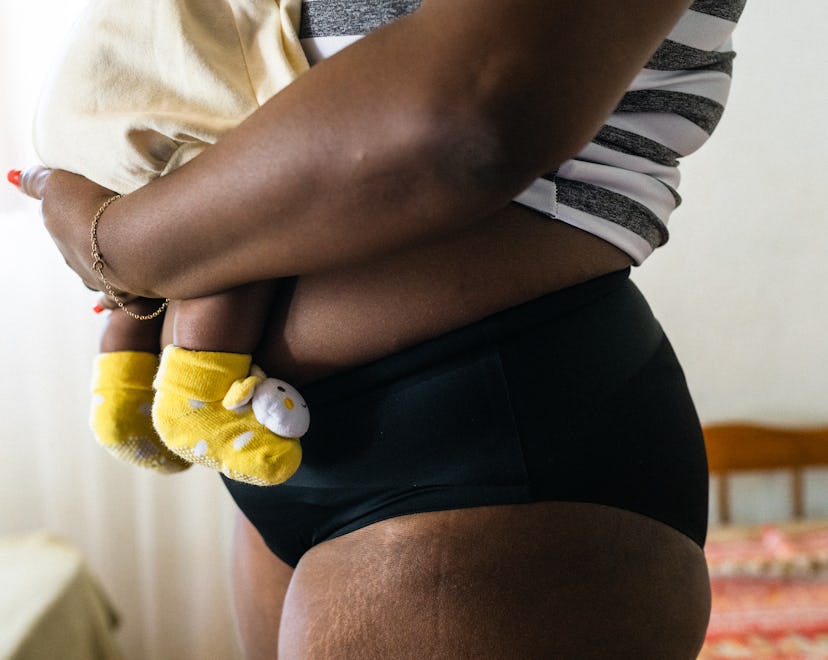Recovery

Everything You Need To Know About Using Dermoplast Postpartum
The pain needs to be addressed.
Whether your delivery was fast and furious (or long and laborious – hence the name), there’s no denying that your lady bits are bound to take a beating. Because if you thought that just pushing your 8-pounder out was the painful part, just wait until you try to take your first postpartum poo in the hospital – usually with an enthusiastic nurse cheering you on from the bathroom doorway. To ease all the aching, you might decide to blast Dermoplast, you know, down there. But if you’re unsure what exactly it is, here’s a Dermoplast postpartum primer on everything you need to know — and then some.
You might not notice right away that your vagina is in agony, especially if you’ve had an epidural and the effects of the medication are lovingly lingering in your system. But once that catheter comes out, prepare to go cross-eyed, momma. Unless you’re one of the lucky ones, an estimated 78% of women experience tearing during childbirth, a PubMed study found. (Another 47.1% experience perineal lacerations.) While stitches can take care of tears, they don’t do much for the pain, unfortunately. And that’s where Dermoplast comes in.
What Is Dermoplast?
There are many ways to soothe some of that postpartum suffering, and Dermoplast is one of them. “Dermoplast is an anesthetic spray that can help to relieve discomfort,” Dr. Marisa Garshick, MD, a board-certified dermatologist at MDCS Dermatology. “It is commonly used in hospitals in the immediate postpartum period and considered safe for use during this time.” According to Dr. Garshick, Dermoplast is particularly beneficial in the first two weeks after delivering your baby.
So, what’s in the topical spray? Lots of things to help relieve discomfort and give your tired skin some TLC. “Dermoplast contains a topical anesthetic known as benzocaine to provide pain relief as well as menthol which has a cooling sensation to help soothe the skin,” says Dr. Garshick. “In addition, the aloe and lanolin can work to help nourish the skin, providing moisture benefits and calming the skin.”
How Do You Use Dermoplast?
Even though your lady parts might be in pain, the last thing you want to do is start poking down there to slather on some cream to aid in the itching. And that’s the cool part of Dermoplast — since it’s a spray, you can just shake it and spray it, aiming in the general area of your vagina and tush. “As an aerosol spray, it can help to relieve pain and itching that can be associated with cuts or skin irritation, as can occur related to any tear in the setting of delivery,” adds Dr. Garshick. “Because it is a spray, it is convenient for use in hard-to-reach areas.”
But Does Dermoplast Work?
Yes, it is effective in alleviating pain, but it won’t make you totally numb to it. “Since it’s a lidocaine spray, it can help with the pain on the surface of your skin and perineum,” Dr. Daniel Roshan, MD, FACOG, FACS, a leading board-certified OB/GYN and high-risk maternal-fetal specialist in New York City tells Romper. “It doesn’t work as well as taking pain medications by mouth.” After all, your pain could be coming from a few places, not just vaginal tears or perineal lacerations. “Your uterus is cramping so that’s where some of the pain comes from, and that’s why oral medication can help better to treat those symptoms.”
Here's What You Can Use In Addition To (Or Instead Of) Dermoplast
It’s a good idea to be flexible when it comes to your pain treatment plan. You never know what might work — or not — depending on how well you’re healing and your pain tolerance. “For pain relief, you can soak your bottom in a bed pan filled with warm water,” advises Dr. Roshan. “And if you’re experiencing uterine pain, you can take 800mg of Motrin every eight hours.”
“You can also use cooling pads which may or may not include witch hazel because those are helpful in soothing postpartum recovery and can be used in place of or in conjunction with Dermoplast,” adds Dr. Garshick. “Many women in the postpartum period find the combination of ice, witch Hazel pads, and Dermoplast to be helpful, though some may have a personal preference, but each work slightly differently to reduce pain, swelling and discomfort.”
As you prepare for the birth of your baby, make sure to figure out what you pain relief aids you might want postpartum. By trying out a variety of methods, you’ll discover which ones work best and have your nether region feeling (almost) like new again.
Study cited:
Samuelsson, E., Ladfors, L., Lindblom, B., Hagberg, H. “A prospective observational study on tears during vaginal delivery: occurrences and risk factors” 2002.
Experts:
Dr. Marisa Garshick, MD, a board-certified dermatologist at MDCS Dermatology
Dr. Daniel Roshan, MD, FACOG, FACS, a leading board-certified OB/GYN and high-risk maternal-fetal specialist in New York City
This article was originally published on